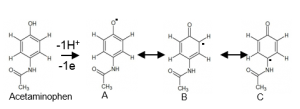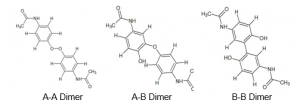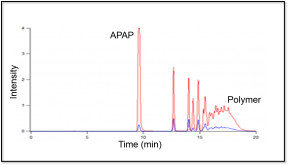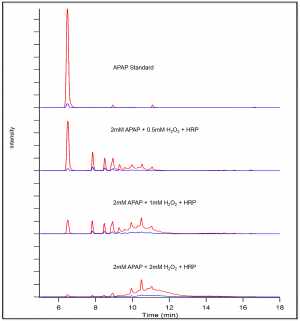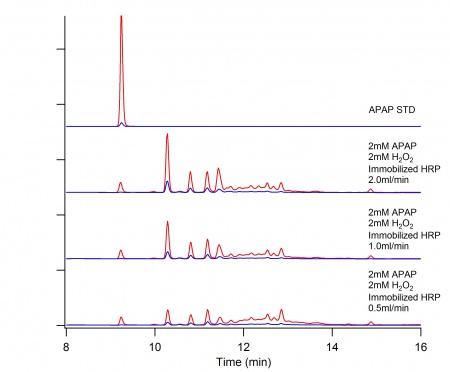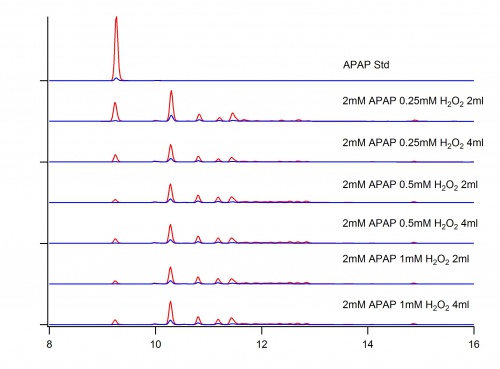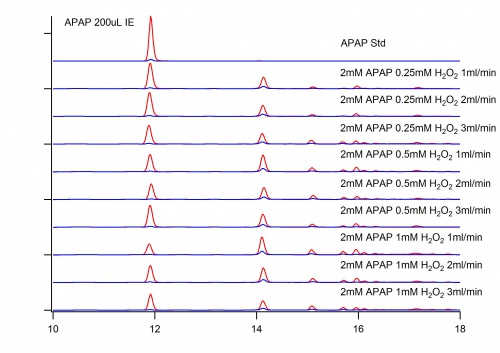Difference between revisions of "Acetaminophen Oxidation"
Ian Salveson (talk | contribs) |
|||
| (14 intermediate revisions by 2 users not shown) | |||
| Line 16: | Line 16: | ||
==Immobilized Enzyme Reactor== | ==Immobilized Enzyme Reactor== | ||
| − | [[File:IE-APAP.jpg|Thumb|left| | + | [[File:IE-APAP.jpg|Thumb|left|450px|alt=Sample Chromatogram|Figure 1: Sample Chromatogram]][[File:APAP 500uL IE2.jpg|Thumb|500px|alt=Sample Chromatogram|Figure 2: Sample Chromatogram]] |
| − | + | [[File:APAP 200uL IE.jpg|Thumb|right|500px|alt=Sample Chromatogram|Figure 3: Sample Chromatogram]] | |
| Line 24: | Line 24: | ||
| − | + | Figures 1 and 2 to the left shows the enzymatic oxidation of acetaminophen using 500uL of an immobilized enzyme. Figure 3 to the right shows the same oxidation using 200uL of immobilized enzyme. | |
| − | |||
| − | |||
| − | |||
| − | |||
| − | |||
| − | |||
| − | |||
| − | |||
| − | |||
| − | |||
| − | |||
| − | |||
| − | |||
| − | |||
| − | |||
| − | |||
| − | |||
| − | |||
| − | |||
==References== | ==References== | ||
1.) Hinson, Jack A., Dean W. Roberts, and Laura P. James. "Mechanisms of Acetaminophen-Induced Liver Necrosis." Handbook of Experimental Pharmacology Adverse Drug Reactions (2009): 369-405. Web. | 1.) Hinson, Jack A., Dean W. Roberts, and Laura P. James. "Mechanisms of Acetaminophen-Induced Liver Necrosis." Handbook of Experimental Pharmacology Adverse Drug Reactions (2009): 369-405. Web. | ||
| − | 2.) Potter, David W., Dwight W. Miller, and Jack A. Hinson. "Identification of Acetaminophen Polymerization Products Catalyzed by Horseradish Peroxidase." Journal of Biological Chemistry 260.22 (1985): 12174-2180. Print | + | 2.) Potter, David W., Dwight W. Miller, and Jack A. Hinson. [[Media:J._Biol._Chem.-1985-Potter-12174-80.pdf|"Identification of Acetaminophen Polymerization Products Catalyzed by Horseradish Peroxidase."]] Journal of Biological Chemistry 260.22 (1985): 12174-2180. Print |
Latest revision as of 14:22, 6 September 2019
Introduction
Acetaminophen(APAP) is an active ingredient in many over-the-counter and prescription painkillers, such as Tylenol and Oxycodone. APAP is also responsible for approximately 50% of the cases of acute liver-failure in the United States and Great Britain(1). Treatments for acetaminophen-induced liver injury(AILI) are limited. The current mechanism for AILI is the production of hepatotoxic NAPQI as a metabolite in an enzymatic, two-electron oxidation(1). However, evidence also supports a one electron oxidation(2). In on effort to reduce the mortality rate of acetaminophen overdose, we are investigating the identity of single-electron, oxidation products and their bioactivity as an alternative mechanism for AILI. Currently, there is no effective treatment for AILI. The first step towards achieving this would be to definitively determine the mechanism of acetaminophen metabolite toxicity.
Methods and Concepts
In order to determine the identities and properties of the single electron oxidation products, it is necessary to first synthesize them. The single electron oxidation can be accomplished by using a system of horseradish peroxidase (HRP) and hydrogen peroxide. HRP carries out two, single-electron oxidations of the substrate, APAP in this case. In regard, to acetaminophen the oxidation most likely will take place at the hydroxyl group of the phenol. The single electron oxidations result in the formation of a reactive radical intermediate which can move exist in several different resonance structures as shown below in figure 1. These radicals have the ability to link; however, due to steric hindrance, resonance structure C is less likely to link. The remaining possible radical dimers are illustrated below in figure 2. Dimer A-A is a peroxide and will be consumed as fuel for the peroxidase cycle. The remaining dimers have a hydroxyl group available to be oxidized again. Repeated oxidations and linkages would result in the formation of polymeric material.
Synthesis, Isolation, and Analysis
The single-electron, oxidation products are synthesized using the system of HRP and hyrdogen peroxide. To confirm the formation of products HPLC was performed on the final solution. Reverse phase HPLC was utilized with a gradient of acetonitrile and 0.1% trifluoroacetic acid. Figure 4 below shows a typical product chromatogram with stoichiometric levels of hydrogen peroxide. As hydrogen is the limiting reagent in the system, it can be used to control the level of oxidation and the levels of different products. Figure 5 below shows how the products change with different levels of hydrogen peroxide. For further analysis it was necessary to isolate specific products. This was done by preparative column chromatography. Figure 6 shows a sample chromatogram of one set of fractions. Once we have isolated a product, Nuclear Magnetic Resonance(NMR) is performed. These results are compared to the NMR of the starting APAP. The differences in NMR signals will tell us where our products are binding.
Current Work
Thus far, we have only been able to isolate one product of the single-electron oxidation of acetaminophen by use of preparative column chromatography. The next option we are investigating is the use of a flash chromatography system for which we would use the same methods of oxidation. Another avenue of exploration which could be would be to control the oxidation of the acetaminophen itself in order to better control the products. This would facilitate the isolation of products. Currently, we have two methods towards this aim. The first method available would be to use an immobilized enzyme system through which our reaction mixture could be flowed. This would limit the interaction between the peroxidase and the acetaminophen. Theoretically, this would allow us to isolate the early products of the repeated oxidation cycle, which we would be able to increase or decrease by adjusting the flow rate. The second method which we are investigating is the use of bulk electrolysis.
Immobilized Enzyme Reactor
Figures 1 and 2 to the left shows the enzymatic oxidation of acetaminophen using 500uL of an immobilized enzyme. Figure 3 to the right shows the same oxidation using 200uL of immobilized enzyme.
References
1.) Hinson, Jack A., Dean W. Roberts, and Laura P. James. "Mechanisms of Acetaminophen-Induced Liver Necrosis." Handbook of Experimental Pharmacology Adverse Drug Reactions (2009): 369-405. Web.
2.) Potter, David W., Dwight W. Miller, and Jack A. Hinson. "Identification of Acetaminophen Polymerization Products Catalyzed by Horseradish Peroxidase." Journal of Biological Chemistry 260.22 (1985): 12174-2180. Print
